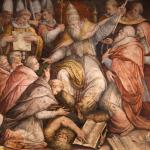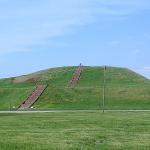John sees one like a son of man on a cloud, holding a sickle (Revelation 14:14). We assume that He’s traveling down to reap the harvest, but is that correct?
The original for this son-cloud combination if Daniel 7:13, where it is clear that the Son of Man comes up to the ancient of days to receive the dominion and authority of the beasts. Jesus quotes this passage (Matthew 24:30; 26:64; Mark 13:26; 14:62; Luke 21:27), and many assume that the son of man is coming down on a cloud. But the link with Daniel 7 is too exact. Jesus isn’t saying that the Son of Man will ride a cloud down in judgment. When the tribes of the land see the signs that Jesus describes in the Olivet Discourse, they will see in those events the exaltation of the Son of Man, Jesus, in the clouds of heaven.
And the connections between the Olivet Discourse and Revelation 14 are suggestive. In both, a “son of man” figure appears on clouds. In the Olivet Discourse, this is connected with the collapse of the heavens and the gathering of the elect from the four corners (Matthew 24:31); in Revelation 14, the son of man has a sickle in his hand to gather in a harvest. The son of man’s posture is unspecified in Matthew 24:30 and its parallels, but in 26:64 and its parallels, the Son of Man is sitting at the right hand of the Power and coming on clouds. Similarly, in Revelation 14:14, the son of man is seated on a cloud, which serves as his chariot or his throne or his chariot-throne.
We may draw these connections: In Daniel 7, the son of man is explicitly ascending on clouds; Jesus quotes Daniel 7 to speak of the coming of the son of man in clouds, presumably implying that the son of man is ascending; Revelation 14 depicts a son of man sitting on a cloud, and given the allusions back to the Olivet Discourse and Daniel 7, we’re justified in concluding that the reaping son of man is also ascending, or perhaps descending and then re-ascending. We are at the very least justified in trying that on for size.
What happens when we do? We get this progression in Revelation 14: First the Lamb appears, standing like a priest amidst the 144,000 (14:1). This is the same Lamb that looked “as if slain” when He first appeared in Revelation 5, and this slain-standing Lamb is among the saints who will soon follow Him to the slaughter. The “one like a son of man” is another Christ figure (cf. 1:13), but now humanized and exalted. If we keep our eye on Jesus in the chapter, we see a replication of Jesus’ progression in the gospel: From slain Lamb to exalted Son of Man. Specifically, we see a replication of the progression of Jesus in the gospel of John, for whom the cross itself is a lifting-up of the Son of Man (John 3:14, alluding to Daniel 7; 12:32).
But the point of Revelation 14 is not that the Lamb is repeating His humiliation and exaltation. Rather, that pattern is non-identically repeated in the lives of the 144,000. First they are with the Lamb on Zion; then they are reaped and gathered by the Son of Man, caught up to the storehouses of heaven.
And this suggests that the saints are going through the same sacrificial sequence that Jesus went through. They are with the slain Lamb on or near the temple Mount of Zion. Jesus ascends as Son of Man in a cloud of sacrificial/incense smoke. Then we see them above the firmament, singing the song of Moses and of the Lamb. Once animals went through the firmament barrier on behalf of worshipers; now with the Lamb who is the Son of Man, martyrs pierce the barrier and sing and harp harps on the sea of glass.
Finally, we can push this one more step: The Lamb is already exalted as Son of Man by His death, resurrection, and ascension. But Jesus is also exalted (further exalted) by the exaltation of the saints. When the Bride is finally revealed, then the Bridegroom is fulfilled: For it is no better for the Last Adam to be alone than for the First.














